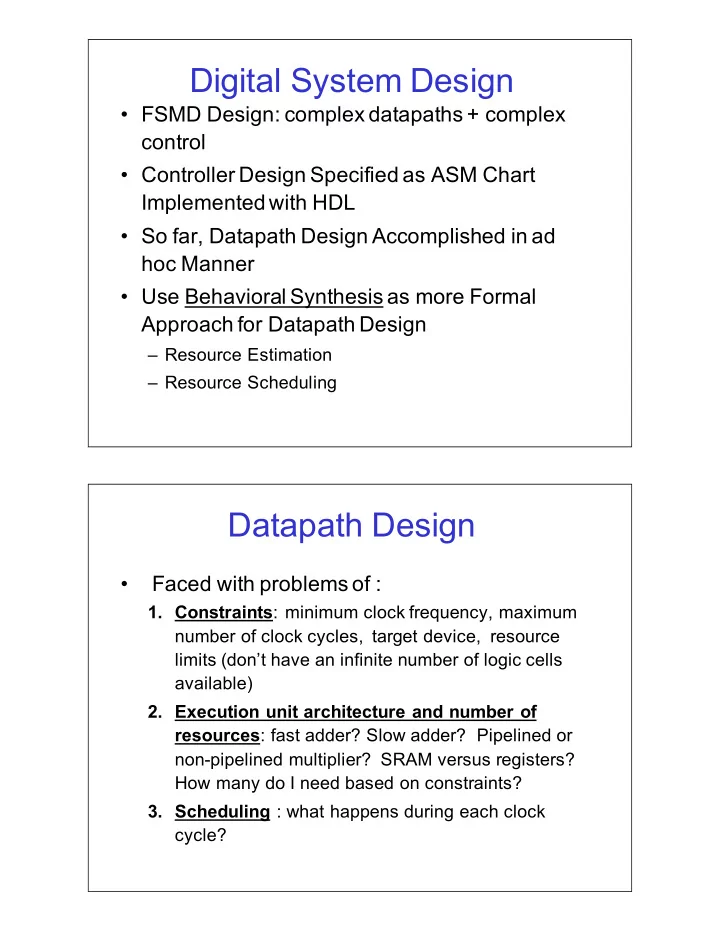

Digital'System'Design • FSMD'Design:'complex'datapaths'+'complex' control' • Controller'Design'Specified'as'ASM'Chart' Implemented'with'HDL • So'far,'Datapath'Design'Accomplished'in'ad' hoc'Manner • Use'Behavioral'Synthesis as'more'Formal' Approach'for'Datapath'Design – Resource'Estimation – Resource'Scheduling Datapath'Design • Faced'with'problems'of': 1. Constraints :'minimum'clock'frequency,'maximum' number'of'clock'cycles,''target'device,''resource' limits'(don’t'have'an'infinite'number'of'logic'cells' available) 2. Execution1unit1architecture1and1number1of1 resources :'fast'adder?'Slow'adder?''Pipelined'or' nonQpipelined'multiplier?''SRAM'versus'registers?'' How'many'do'I'need'based'on'constraints? 3. Scheduling :'what'happens'during'each'clock' cycle?
Constraints • Two Constraints that'can'be'placed'on'a'digital' system'design'are'clock'period'and'clock'cycle' constraints' • A' Clock,period,constraint, will'define'the'clock' frequency. – Will'affect'the'architecture'of'your'execution'units'(fast' adder'versus'slow'adder,''pipelined'execution'unit'versus' nonQpipelined'execution'unit) • A' Clock,cycle,constraint, limits'the'available'number' of'clock'cycles'to'perform'operation'Q throughput • Total'computation'time:'(clock'period × clock'cycles) • Other'constraints:'Power,'device'type,'Input/Output Resource'Estimation • Given'constraints,'would'like'a'lower'bound' estimate'on'the'number'of'resources'needed • Resource'types:''Registers,'Execution'units' (adders,'multipliers,'etc) • Lets'do'resource'estimation'for'the'equation' below: Y = a0 * x + a1 *x@1 + a2 * x@2 + a3 * x@3 FIR x Y Computation
FIR'Filter'Example Y = a0 * x + a1 *x@1 + a2 * x@2 + a3 * x@3 The'equation'above'is'an'equation'for'a'4QTap'Finite'Impulse' Response'digital'filter. Each' sample,period a'new'value'for X is'input'to'the'system.'A' sample'period'is'measured'in'clock'cycles,'and'the'number'of' clock'cycles'per'sample'period'will'be'an'external'constraint. x is'the'value'for'current'sample'period. x@1 is'the'value'for'one'sample'period'back. x@2 is'the'value'for'two'sample'periods'back. x@3 is'the'value'for'three'sample'periods'back. a0, a1,a2,a3 are'the'filter'coefficients.''Changing'these' coefficients'change'the'filter'functionY'assumed'to'be' preloaded. Dataflow'Graph We'need'a'method'of'visualizing'the'data'dependencies'and' operations'to'be'performed.''One'method'of'doing'this'is'the' dataflow, graph. x@1 a1 x a0 x@2 a2 x@3 a3 * * * * + + + Y
Operations'in'a'Dataflow'graph An'input'operation.''Inputs'are'assumed' x registered.''An'input'operation'requires'1' clock'cycle. An'output'operation.''Outputs'are'assumed'to' not'be'registered'because'they'will'be' Y registered'by'the'following'datapath'they' produce'output'for. An'execution'unit'operation.''Based'on' clock'period'constraints,'execution'units' can'be' chained (a'multiplier'output'directly' + feeding'an'adder'input'without'an' intervening'register)'or' non)chained (all' inputs/outputs'of'execution'units'are' registered). Minimum'Required'Clock'Cycles Assume'that'clock'period'constraint'does'not'allow'execution' unit'chaining'(registers'are'between'execution'units).''Minimum' #'of'clock'cycles'will'be'longest'path'through'the'datapath. x@1 a1 N1 x a0 x@2 a2 x@3 a3 N2 * * N3 N4 * * N5 + N6 + N7 + N8 Minimum, Longest, sample, path,is,4, Y period,is,4, clock, clocks. cycles
Resource'Estimation Given'a'clock'cycle'constraint'(sample'period),'can'estimate' minimum'number'of'needed'resources. Assume'the'minimum'sample'period'of'4'clocks. Minimum'resource'estimation'is: #'operations/'#'of'clocks Minimum'Resource'estimation: #'multipliers'=''#'multiplies/'#'clocks'='4/4'=''1 #'adders'=''#'additions/'#clocks'='3'/4''='1 Minimum'resource'estimation'is''1'multiplier,'1'adder.'' Register'estimation'is'tougher.'''Need'to'store x@1, x@2, x@3, a0, a1, a2, a3. Need'at'least'7'registers. Resource'Scheduling Scheduling is'the'mapping'operations'onto'execution' units.''A'scheduling'table'lists'clock'cycles'versus' resources.'''Register'Scheduling'is'addressed'later. Cycle Adder Multiplier IO Start #1 idle Reg?? ← x@3*a3 (N5) Input X #2 idle Reg?? ← x@2*a2 (N4) #3 N7 op (N5+N4) Reg?? ← x@1*a1 (N3) #4 idle Reg?? ← x*a0 (N2)
Scheduling'Failed The'scheduling'failed.''Not'possible'to'schedule'the'adder' operations'represented'by'nodes'N6'and'N8'in'the'4'clock' cycle'budget. The'minimum'resource'estimation'is'a' lower,bound Y'it'may' not'be'possible'to'find'a'schedule'to'fit'it. If'scheduling'fails,'there'are'two'options: a.''Increase'resources,'keep'same'#'of'clocks b.''Increase'#'of'clocks,'keep'same'number'of' resources For'minimum'sample'period,'determine'which'resource'to' add. The'bottleneck'is'the'multiplier.''Lets'add'another'multiplier. Resource'Scheduling''(2nd'try) Resource: Adder Mult A Mult B IO Cycle Start #1 idle x@3*a3 (N5) x@2*a2 (N4) Input X #2 N7 op (N5+N4) x@1*a1 (N3) x*a0 (N2) #3 N6 op (N3+N2) idle idle #4 N8 op (N7+N6) idle idle Scheduling'is'Successful
Register'Allocation At'this'point,'need'to'allocate'registers'to'save' temporary'results.''At'beginning'of'operation,'we'know' that'we'need'to'have'the'values a0, a1, a2, a3, x@3, x@2, x@1 stored.''So'we'need'at'least'7'registers.'' The'registers'holding a0-a3 will'not'change'value' during'the'computation,'so'we'will'not'consider'them'in' our'scheduling. Assume'at''Start: RA = x@3, RB=x@2, RC=x@1 Register'Scheduling'(Clock'#1) Regs: RA = x@3, RB=x@2, RC=x@1 Clock'1: Input'X??? Where'to'put'this?''For'now,'use'new'register'RegD. Input' x : RD ← x x@3*a3 (N5): RA ← RA*a3 (don’t'need x@3 after'this,'destroy RA ) x@2*a2 (N4): ?? ← RB*a2 (will'need x@2 next'time,'can’t'destroy RB ) Add'another'register x@2*a2 (N4): RE ← RB*a2 (will'need x@2 next'time,'can’t'destroy RB ) Scheduling'this'operations'forced'us'to'add'two'additional'registers:' RD, RE Next,'perform'register'scheduling'for'Clock'#2
Register'Scheduling'(Clock'#2) Regs: RA = N5, RB=x@2, RC=x@1, RD=x, RE=N4 Clock'2: N4 + N5 (N7): RA ← RE+RA (destroy'RA,'don’t'need'N5'anymore) x@1*a1 (N3 ): ?? ← RC*a1 (will'need'x@1'next'time,'can’t'destroy'RC) Look'for'a'free'register.'''Don’t'need RE (N4) after'this'clock'cycle,'use'it. x@1*a1 (N3 ): RE ← RC*a1 (store'result'in RE ) x*a0 (N2): ?? ← RD*a0 (will'need'“ x ”'next'time,'can’t'destroy RD )' Any'free'registers?''NO.''Add'another'register. x*a0 (N2): RF ← RD*a0 Scheduling'these'operations'forced'us'to'add'one'more'register: RF Next,'perform'register'scheduling'for Clock'#3 Register'Scheduling'(Clock'#3,'Clock'#4) Regs: RA = N7, RB=x@2, RC=x@1, RD=x, RE=N3, RF=N2 Clock'3: N6 op (N3+N2): RE ← RE + RF (destroy RE ,'don’t'need N3 anymore) Regs: RA = N7, RB=x@2, RC=x@1, RD=x, RE=N6, RF=N2 Clock'4: N8 op (N7+N6): Y ← RA + RE (output'is'unregistered) Must'consider'initial'conditions'for'next'sample'period:' RA = x@3, RB=x@2, RC=x@1 x@1 ← x RC ← RD Note'that x in'this'sample'period'becomes x@1 x@2 ← x@1 RB ← RC for'the'next'sample'period, x@1 becomes x@2, x@3 ← x@2 RA ← RB etc...
Final'Datapath'Requirements • For'sample'period'='4'clocks: –2'Multipliers,'1'adder –10'registers'( RA-RF ,'plus'4'registers'for a0,a1,a2,a3 ) • Is'this'the'best'hardware'allocation? –Maybe'not,'if'we'try'harder'may'be'able' to'reduce'the'number'of'registers • Lets'go'with'this'and'develop'the' datapath'diagram Datapath'Unit'Sources'&'Destinations Mult'A:''Left'sources: RA, RC Right'sources: a3, a1 Mult'B:''Left'sources: RB, RD Right'sources: a2, a0 Adder:''Left'sources: RE, RA Right'sources: RA, RF, RE RA'src: MultA, Adder, RB RB'src: RC RC'src: RD RD'src: X RE'src: Adder, Mult A, Mult B RF'src: Multiplier B a0-a3 registers'loaded'from'external'databus X
Minimum'Required'Clock'Cycles Assume'that'clock'period'constraint'does'not'allow'execution' unit'chaining'(registers'are'between'execution'units).''Minimum' #'of'clock'cycles'will'be'longest'path'through'the'datapath. x@1 a1 N1 x a0 x@2 a2 x@3 a3 N2 * * N3 N4 * * N5 + N6 + N7 + N8 Minimum, Longest, sample, path,is,4, Y period,is,4, clock, clocks. cycles Datapath' ma add ma add mb x rd mb A0-A3 RD RA RB RC RE RF a2 a0 a3 a1 Mult B Mult A adder mb ma add Y
Recommend
More recommend